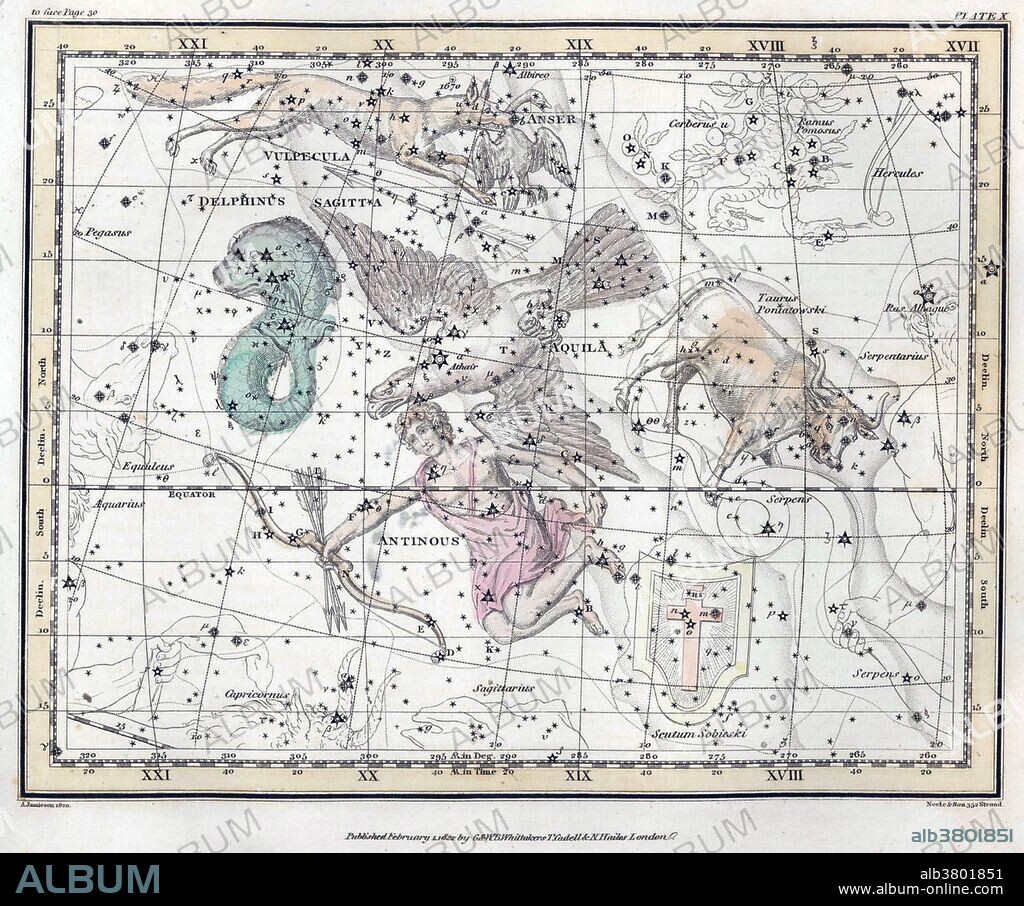alb3801851
Northern Sky Constellations, 1822

|
Add to another lightbox |
|
Add to another lightbox |



Buy this image.
Select the use:

Title:
Northern Sky Constellations, 1822
Caption:
Antinous is an obsolete constellation no longer in use by astronomers, having been merged into Aquila, which it bordered to the North. Aquila constellation, its name is Latin for eagle and it represents the bird who carried Zeus/Jupiter's thunderbolts in Greco-Roman mythology. Aquila lies just a few degrees North of the celestial equator. Delphinus constellation is close to the celestial equator. Its name is Latin for dolphin. It is one of the smaller constellations, ranked 69th in size. Delphinus' brightest stars form a distinctive asterism that can easily be recognized. Vulpecula is a faint constellation. Its name is Latin for little fox, although it is commonly known simply as the fox. It was identified in the seventeenth century, and is located in the middle of the Summer Triangle (an asterism consisting of the bright stars Deneb, Vega and Altair). A Celestial Atlas (1822) by Alexander Jamieson, inspired by the star atlas of Johann Elert Bode, but restricted itself to stars that could be seen with the naked eye. Comprising a systematic display of the heavens in a series of thirty maps illustrated by scientific description of their contents and accompanied by catalogues of the stars and astronomical exercises, plate 10, 1822.
Category:
ILLUSTRATION • Astronomy & Space • Science: History
Credit:
Album / Science Source / U.S. Naval Observatory Library
Releases:
Image size:
3600 x 2999 px | 30.9 MB
Print size:
30.5 x 25.4 cm | 12.0 x 10.0 in (300 dpi)
Keywords:
1822 • 19TH CENTURY • ALEXANDER JAMIESON • ANTINOUS • AQUILA • ART • ARTWORK • ASTERISM • ASTRONOMIA • ASTRONOMICAL • ASTRONOMY & SPACE • ASTRONOMY • CELEBRITIES • CELEBRITY • CELESTIAL ATLAS • CELESTIAL BODY • CELESTIAL SPHERE • CELESTIAL • CONSTELLATION • DELPHINUS • DOLPHIN, THE • DRAWING • EAGLE, THE • ENGRAVING • FAMOUS PEOPLE • FAMOUS • FOX, THE • HEAVENLY BODY • HEAVENLY • HISTORIC • HISTORICAL • HISTORY • ILLUSTRATION • ILLUSTRATIONS • ILUSTRATION • IMPORTANT • JAMIESON • LITTLE FOX, THE • NOTABLE • PATTERN OF STARS • SCIENCE • SCIENCE: HISTORY • STAR ATLAS • STAR CHART • STAR MAP • VULPECULA • WELL-KNOWN


 Pinterest
Pinterest Twitter
Twitter Facebook
Facebook Copy link
Copy link Email
Email
